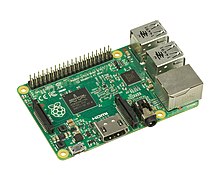
Back حاسوب وحيد اللوحة Arabic Tək-lövhəli kompüter AZ Едноплатков компютър Bulgarian SBC Catalan Jednodeskový počítač Czech Single-board computer Danish Einplatinencomputer German Computadora monoplaca Spanish Monoplaatarvuti ET رایانه تک برد FA
This article has multiple issues. Please help improve it or discuss these issues on the talk page. (Learn how and when to remove these messages)
|

A single-board computer (SBC) is a complete computer built on a single circuit board, with microprocessor(s), memory, input/output (I/O) and other features required of a functional computer. Single-board computers are commonly made as demonstration or development systems, for educational systems, or for use as embedded computer controllers. Many types of home computers or portable computers integrate all their functions onto a single printed circuit board.
Unlike a desktop personal computer, single-board computers often do not rely on expansion slots for peripheral functions or expansion. Single-board computers have been built using a wide range of microprocessors. Simple designs, such as those built by computer hobbyists, often use static RAM and low-cost 32- or 64-bit processors like ARM. Other types, such as blade servers, would perform similar to a server computer, only in a more compact format.
A computer-on-module is a type of single-board computer made to plug into a carrier board, baseboard, or backplane for system expansion.[2][3]
- ^ "Foundation Strategy 2016–2018" (PDF). Raspberry Pi. Raspberry Pi Foundation. pp. 3–5. Archived (PDF) from the original on 9 June 2016. Retrieved 26 November 2016.
- ^ "COM – Based SBCs: The Superior Architecture for Small Form Factor Embedded Systems" (PDF). Diamond Systems Corp. Archived (PDF) from the original on 29 December 2016. Retrieved 27 December 2016.
- ^ "Implementing High Performance Embedded Computing Hardware" (PDF). Trenton Systems, Inc. September 1, 2016. pp. 13–15. Archived (PDF) from the original on 26 November 2016. Retrieved 26 November 2016.